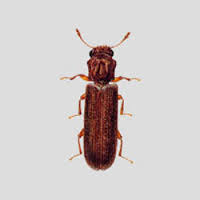 Who is to blame for wood boring beetles if they are in the lumber? The homeowner facing an expensive fumigation would prefer that someone else paid the bill. If it can be shown that the insects were built in with infested lumber then the builder is considered to be at fault, and he in turn blames his supplier of the wood. You may be standing there as “the expert” trying to keep an angry homeowner and a frustrated builder apart as The Blame Game proceeds. There was a home a little over one year old, and True Powderpost Beetles were infesting a nice oak floor and the question was - did the beetles find their own way in right after the home was built, or was that oak flooring infested prior to its use? Typically these beetles will run through their life cycle in less than one year, but things may happen that may delay their development, and its not so easy to provide providing a firm answer.
Who is to blame for wood boring beetles if they are in the lumber? The homeowner facing an expensive fumigation would prefer that someone else paid the bill. If it can be shown that the insects were built in with infested lumber then the builder is considered to be at fault, and he in turn blames his supplier of the wood. You may be standing there as “the expert” trying to keep an angry homeowner and a frustrated builder apart as The Blame Game proceeds. There was a home a little over one year old, and True Powderpost Beetles were infesting a nice oak floor and the question was - did the beetles find their own way in right after the home was built, or was that oak flooring infested prior to its use? Typically these beetles will run through their life cycle in less than one year, but things may happen that may delay their development, and its not so easy to provide providing a firm answer.
Begin by determining exactly which insect you have. Then you can learn about its biology and life cycle and have a much better idea of what you are dealing with. We have only a few groups of wood infesting beetles that might warrant a structural fumigation. But, it is important to learn about the other kinds as well and how to distinguish them. It also is important to be able to identify the beetle based on evidence that may be left behind, and this will be such things as the exit holes created by the adult beetle as it leaves the wood, or the fecal material created by the feeding larva.
The most dramatic of the beetle families, and that is the family Cerambycidae – the Long Horned Wood Boring Beetles. This is an amazing group of beetles, and in it you can find species that are very small or others that are the largest beetles in North America. In South America one species grows to over 6 inches in length, and is named, appropriately, Titanus giganteus – the Titan Beetle. There is a species shaped like a violin, others that are strong mimics of bumblebees, and in general a great variety of kinds. Some species will feed on living trees, usually in the branches where they do not threaten the overall health of the tree. But, some, like the imported Asian Long Horn, do their work in the trunk, and are a serious threat to forests. Most, though, are drawn to dead trees, and are the first insects on the scene when the process of recycling begins. There are two species that seem commonly to be found inside homes, and these are species in the genus Prionus, commonly referred to as “pine” beetles, and a smaller kind called the Nautical Borer. And, along the eastern states in the U.S., there also are two species of Cerambycids that do infest structural wood, and could result in a fumigation to eradicate them.
The Nautical Borer is notable only because it so often infests hardwoods that are used for firewood, such as oak. These medium sized black beetles complete their life cycle in just one year, and then emerge from the wood as the adult beetle once the wood warms up in the spring. If a dead oak tree is cut into firewood we sometimes accelerate the process a bit by bringing the firewood inside the home in the winter. Suddenly dozens of the adult beetles are running all over the floors and walls, looking much like large black spiders. For example, a piece of oak no longer than 18 inches and about 8 inches in diameter, managed to have nearly 60 beetles in a single piece of wood. The remedy for this beetle is to vacuum them up and put the wood back outside until it is going to be burned. The adults will not lay eggs on any wood in the structure, re-infestation is not going to happen in structural wood, and no chemical control of any kind is needed.
When a saw blade cuts across a feeding channel in lumber, it exposes the fecal material, leaving it still packed tightly in the channel, but now showing at the surface of the milled lumber. When you see this on rough lumber in a structure, perhaps floor joists or rafters in the attic, you can be assured that it is evidence only of an old infestation by the beetles, and it is highly unlikely that any beetle larvae still are living within the wood. The beetle larva is not going to feed at the surface and then pack the hole with fecal matter. Instead, they remain hidden inside the wood and away from light. It may be prudent to note this evidence on your inspection report, but no recommendation for fumigation or chemical treatment is needed. Contact Lady Bug Pest Control Specialists for a Free Home Inspection for Termites, Eco-Friendly Pest Control, Home Seal Service, Bed Bug Eco-Heat, and Rodent Control. We perform Complete Home Inspections at no charge. Please feel free to contact Lady Bug Pest Control Specialists to answer any questions or for a FREE Inspection. 480-833-1111.
Who is to blame for wood boring beetles? Mesa, AZ
At Lady Bug use a variety of environmentally responsible products to control pest activity. The ECO line of products we use are all EPA approved and are made from clove oil, guava fruit, rosemary and other organic products and naturally occurring materials. They are very effective against pests when injected into the cracks and crevices at the source of where pests live and breed, yet it is inaccessible to people and pets.







